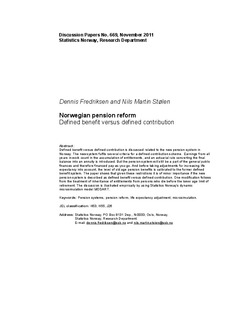Norwegian pension reform : defined benefit versus defined contribution
Working paper

Åpne
Permanent lenke
http://hdl.handle.net/11250/180411Utgivelsesdato
2011Metadata
Vis full innførselSamlinger
- Discussion Papers [1003]
Sammendrag
Abstract:
Norway. The new system fulfils several criteria for a defined contribution scheme. Earnings from all years in work count in the accumulation of entitlements, and an actuarial rule converting the final balance into an annuity is introduced. But the pension system will still be a part of the general public finances and therefore financed pay-as-you-go. And before taking adjustments for increasing life expectancy into account, the level of old age pension benefits is calibrated to the former defined benefit system. The paper shows that given these restrictions it is of minor importance if the new pension system is described as defined benefit versus defined contribution. One modification follows from the treatment of inheritance of entitlements from persons who die before the lower age limit of retirement. The discussion is illustrated empirically by using Statistics Norway’s dynamic microsimulation model MOSART.
Keywords: Pension systems, pension reform, life expectancy adjustment, microsimulation_______________ To reduce future challenges for public finances caused by an increasing number of
elderly, a reform of the old age pension system in Norway is implemented from
2011. Like in most other Western countries the expected increase in the future
pension burden is caused by higher life expectancy and relatively large cohorts
born in the years after the Second World War. These cohorts are now reaching the
age of retirement. When the former system was established in 1967, the number of
retirees was low relative to those in working age. In spite of increasing life
expectancy, financing the old age pension scheme in Norway pay-as-you-go has up
to now only caused a small tax burden for the working population.